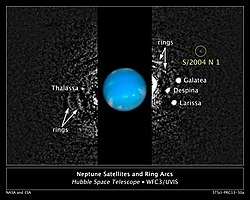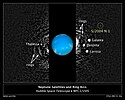Hippocamp
| Hippocamp | |
 Sammansatt fotografi från Hubbleteleskopet (2009) som visar Neptunus, Hippocamp, några av Neptunus ringar och några av de inre månarna. Ljusstyrkan hos månarna har utökats i förhållande till Neptunus. | |
| Upptäckt | |
|---|---|
| Upptäckare | Mark R. Showalter, I. de Pater, Jack J. Lissauer, R. S. French[1][2] |
| Upptäcktsdatum | 1 juli 2013 |
| Uppkallad efter | hippokampos |
| Omloppsbana | |
| Excentricitet | ~ 0,000[3] |
| Siderisk omloppstid | 0,9362 d[2] |
| Inklination | ~0,0° |
| Måne till | Neptunus |
| Fysikaliska data | |
| Medelradie | 8–10 km[2] |
| Albedo | 0,01 |
| Skenbar magnitud | +26,5[2] |
| Hitta fler artiklar om astronomi med | |
Hippocamp är en av Neptunus naturliga satelliter, och kretsar kring Neptunus på en tidsperiod som motsvarar ett jorddygn. Den upptäcktes den 1 juli 2013.[4] Det reflekterade ljuset är så svagt att den inte hittades då Voyager 2 flög förbi 1989. Mark Showalter vid SETI Institute hittade satelliten då han analyserade arkiverade fotografier tagna av Hubbleteleskopet mellan åren 2004 och 2009.[5]

Namngivning
Månen fick först namnet "S/2004 N 1" som syftar på första året då data hämtades, inte upptäcktsåret.[1]
I februari 2019 godkände astronomiska unionen namnet Hippocamp[6]. Namnet kommer från Hippokampos, som är en mytologisk varelse i den grekiska mytologin och består framtill av en häst och baktill av en fisk.
Källor
- Den här artikeln är helt eller delvis baserad på material från engelskspråkiga Wikipedia, 8 oktober 2013.
Fotnoter
- ^ [a b] Yeomans, D. K. ;Chamberlin, A. B. (15 juli 2013). ”Planetary Satellite Discovery Circumstances” (på engelska). JPL Solar System Dynamics web site. Jet Propulsion Lab. https://ssd.jpl.nasa.gov/?sat_discovery. Läst 17 november 2014.
- ^ [a b c d] Kelly Beatty (15 juli 2013). ”Neptune's Newest Moon” (på engelska). Sky & Telescope. Arkiverad från originalet den 16 juli 2013. https://archive.is/20130716121048/http://www.skyandtelescope.com/news/Neptunes-Newest-Moon-215535121.html. Läst 17 november 2014.
- ^ Redaktörerna för Sky & Telescope. ”A Guide to Planetary Satellites” (på engelska). Sky & Telescope web site. Sky & Telescope. Arkiverad från originalet den 16 oktober 2013. https://web.archive.org/web/20131016023130/http://www.skyandtelescope.com/observing/objects/planets/A_Guide_to_Planetary_Satellites.html?page=4. Läst 17 november 2014.
- ^ ”Hubble Finds New Neptune Moon”. Space Telescope Science Institute. 15 juli 2013. http://hubblesite.org/newscenter/archive/releases/2013/30/full/. Läst 15 juli 2013.
- ^ ”Nasa's Hubble telescope discovers new Neptune moon”. BBC News. 15 juli 2013. http://www.bbc.co.uk/news/science-environment-23318301. Läst 16 juli 2013.
- ^ Mortillaro, Nicole. ”Scientists reveal Neptune's tiny new moon, Hippocamp”. https://www.cbc.ca/news/technology/neptune-moon-hippocamp-1.5025091. Läst 12 augusti 2023.
| ||||||||
Media som används på denna webbplats
This diagram shows the orbits of several moons located close to the planet Neptune. All of them were discovered in 1989 by NASA's Voyager 2 spacecraft, with the exception of S/2004 N 1, which was discovered in archival Hubble Space Telescope images taken from 2004 to 2009. The moons all follow prograde orbits and are nestled among Neptune's rings (not shown). The outer moon Triton was discovered in 1846 — the same year the planet itself was discovered. Triton's orbit is retrograde, suggesting it is a captured Kuiper Belt object and therefore a distant cousin of Pluto. The inner moons may have formed after Triton's capture several billion years ago.
This composite Hubble Space Telescope picture shows the location of a newly discovered moon, designated S/2004 N 1, orbiting the giant planet Neptune. The moon is so small (no more than 12 miles across) and dim, it was missed by NASA's Voyager 2 spacecraft cameras when the probe flew by Neptune in 1989. Several other moons that were discovered by Voyager appear in this 2009 image, along with a circumplanetary structure known as ring arcs.
Mark Showalter of the SETI Institute discovered S/2004 N 1 in July 2013. He analyzed over 150 archival Neptune photographs taken by Hubble from 2004 to 2009. The same white dot appeared over and over again. He then plotted a circular orbit for the moon, which completes one revolution around Neptune every 23 hours. The black-and-white image was taken in 2009 with Hubble's Wide Field Camera 3 in visible light. Hubble took the color inset of Neptune on August 19, 2009.

